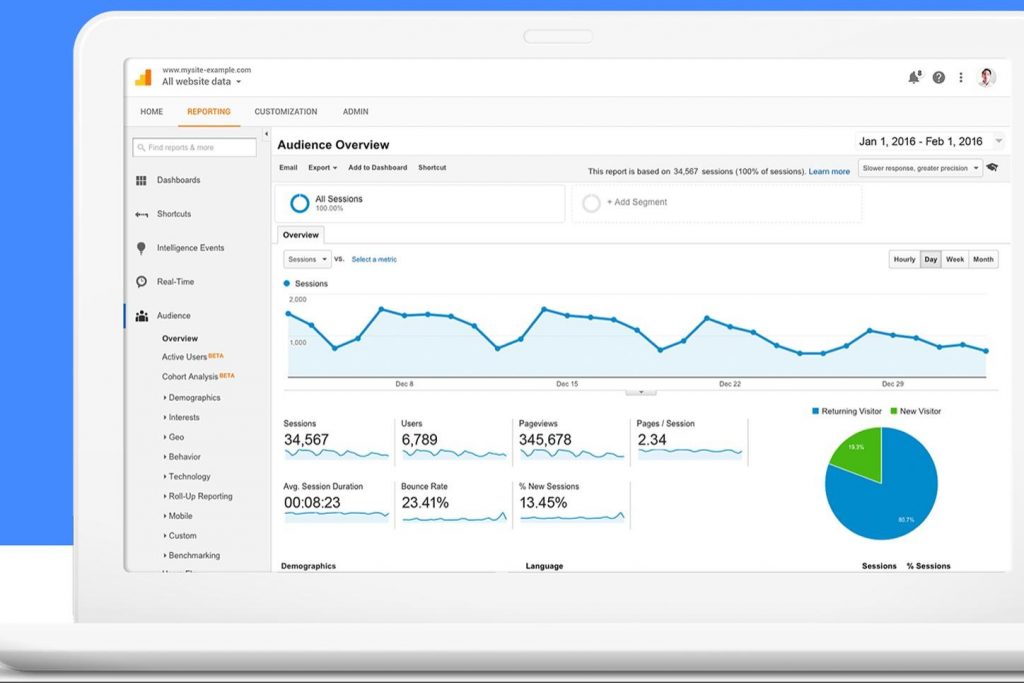What Is The Difference Between Sessions, Users, Pageviews and Unique Pageviews?
Four important website metrics that every business owner should understand about their website.

Using Google Analytics can be confusing for many business owners. With so many metric to consider, it can be easy to get lost and overwhelmed with all the data. In this article we will explain the four essential metrics that every business owner should understand:
Keep reading to discover what these metrics are and their key differences.
The Four Essential SEO Metrics
What Are Sessions?
Sessions are the group of user interactions that occur on your website during a specific time period of time. When a visitor arrives at your website, a session “cookie” activates. These cookies typically expire after 30 minutes. With sessions, the number of pages viewed or what activities the user is engaging in are not considered.
Sessions end when the visitor stops doing any activity on your website for 30 minutes. In most cases, this occurs when the visitor arrives at your site and then opens a new window to explore another site. A midnight deadline also exists for sessions. Let’s say that a user visits a site at 11:45 p.m., but continues browsing until after midnight. Google Analytics considers this two sessions, even though the browsing period may have only been 15 minutes.
So, why is it important to measure sessions? Technically speaking, sessions give you the exact number of times visitors opened your site and remained engaged. On average, a “good” session length is about 2-3 minutes.
What is a User?
Whenever a person visits your website for the first time, Google Analytics creates a unique user ID in order to identify the visitor as a unique User. The visitor’s browser stores this information as a cookie, meaning that the ID is unique to that person.
Additionally, the cookie is specifically identified on the user’s browser. This means that if the visitor uses a different browser to view your site at a later time, Google Analytics will record him or her as a new user. However, this is uncommon, as people typically use the same browser to view different websites. For this reason many experts consider the “Users” metric to be as synonymous to “unique website visitors coming from different computers or IP addresses”. However, this is not accurate since a user can be using one computer, and have two browsers open – say Google Chrome and Internet Explorer – and go to the same website, and they would be counted as two different Users.
What Are Pageviews?
One of the easiest metrics to understand, a pageview simply is the total number of times a website page has been visited. Even if one person clicks on your page several times, each visit is recorded as a single pageview.
Tracking pageviews helps marketers decide whether their initiatives are meeting expectations. It’s especially important to analyze pageviews when you’re considering a site redesign or implementing a new digital strategy. If certain money pages are not getting a substantial amount of pageviews, then the website should be re-designed to make these pages more prominent in order to get visitors to click through to them.
Pageview data can also be combined with other metrics such as “Average time on page”, to determine the effectiveness of the specific page(s) – if people are quickly leaving a page, then that page should be re-designed to keep visitors more engaged.
What Are Unique Pageviews?
Unique pageviews are directly related to the Pageviews metric explained above. However, with unique pageviews, multiple views or refreshes by the same user do not increase the view count. Instead, the unique pageview metric counts the series of refreshes as only one view.
Real Life Example To Put Everything Into Perspective
Now that we’ve outlined what sessions, users, pageviews and unique pageviews are, it’s time to explore how to differentiate them. Here’s an example to better illustrate these three terms:
A user arrives on your website on June 1. While browsing the site, the user visits the About Us page, the homepage, as well as the Contact Us page. This user is the only person on your site at the time, so the Google Analytics profile will record one session, three pageviews, and one user.
A user arrives on your website on June 1. While browsing the site, the user visits the About Us page, the homepage, as well as the Contact Us page. This user is the only person on your site at the time, so the Google Analytics profile will record one session, three pageviews, and one user.
Let’s say that the person revisits your website the next day and visits the same three pages. In this case, the profile will read two sessions, one user, and six pageviews. Because the user visited your site the next day, two sessions will be recorded. However, if the visitor used the same device to access the page, Google Analytics will show one user. The pageviews are simply the number of pages the visitor loaded. Since the user visited three pages over two sessions, the pageview total is six.
Pageviews vs. Unique Pageviews
Each time a user clicks the “Refresh” button, it is as if he or she is requesting new data from the server. This rebuilds the webpage as the data appears on the screen. Google Analytics counts these refreshes as separate pageviews; therefore, it’s important to take this into consideration when you are viewing the pageview metric.
While the data may show 200 pageviews, that doesn’t mean it was 200 different users. This is when unique pageviews come into play. This metric shows the exact number of different visitors who have accessed your site. The Unique Pageview field is located in the Top Content report in your Google Analytics report.
Conclusion
While there are hundreds of metrics displayed in Google Analytics reports, the four most valuable metrics that give the business owner an accurate overview of their website’s performance are: sessions, users, pageviews, and unique pageviews.
Other metrics such as the percentage of new visitors vs returning visitors, the time they spend on your page, which sources they are coming to the website from, which pages they are leaving your website from etc, are also very important metrics to look at and we will discuss these in future articles. However, understanding sessions, users, pageviews, and unique pageviews will provide business owners with a clear picture of their site’s performance at a quick glance.
